LILYGO T-ETH-Elite is an ESP32-S3-powered IoT board with an Ethernet RJ45 port supporting PoE and a 40-pin GPIO header for stackable shields that offer support for LoRaWAN, 2G, NB-IoT, or/and 4G LTE cellular connectivity.
The ESP32-S3 board allows users to build gateways with Ethernet, WiFi, Bluetooth, GNSS, LoRaWAN, and Cellular (2G, NB-IoT, 4G LTE) connectivity, and they can easily switch cellular modules to match specific requirements.
LILYGO T-ETH-Elite specifications:
- Wireless module – Espressif ESP32-S3-WROOM-1
- MCU – ESP32-S3R8 dual-core Tensilica LX7 up to 240 MHz with 512KB SRAM, up to 8MB PSRAM
- Storage – 16MB flash
- Connectivity – WiFi 4 and Bluetooth LE 5
- PCB antenna
- Storage – MicroSD card slot
- Networking – 10/100Mbps Ethernet RJ45 port via W5500 SPI to Ethernet chip
- USB – USB Type-C port for power and programming
- Expansion – 40-pin (mostly) Raspberry Pi-compatible GPIO header for shields (up to 23x GPIO, USB 2.0, UART, 5V, 3.3V, and GND)
- Misc
- Reset and Boot buttons
- User LED (IO38), 5V and 3.3V power LEDs
- USB OTG switch
- Power Supply
- 5V/500mA via USB-C port
- 36V to 57V via PoE (802.3af)
- Dimensions – 67 x 50 mm
The T-ETH-Elite board can be fitted with one or more stackable expansion boards connected through the 40-pin GPIO header:
- LTE Shield with L76K GPS module and T-PCIe expansion for cellular mPCIe modules from the company:
- T-PCIE SIM7000X Series 2G NB-IoT
- T-PCIE SIM7020X Series NB-IoT
- T-PCIE SIM7600X Series 4G LTE Cat 4
- T-PCIE A7608X-H Series 4G LTE Cat 4
- T-PCIE A7670X Series 4G LTE Cat 1
- Gateway Shield with L76K GPS module and the mPCIe SX1302 LoRa gateway module from the company
- LoRa Shield with L76K GPS module and optional LoRa module soldered on the board either LR1121, SX1262, SX1276,SX1280
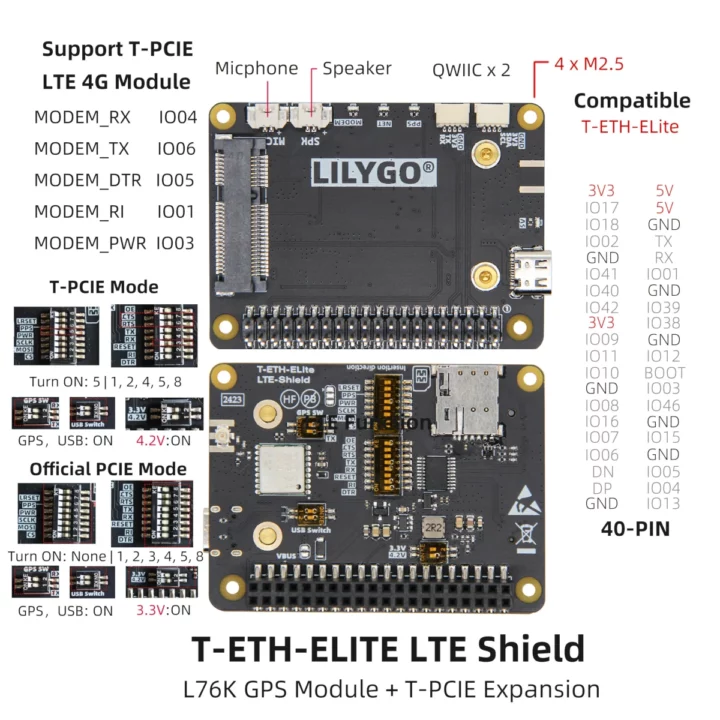
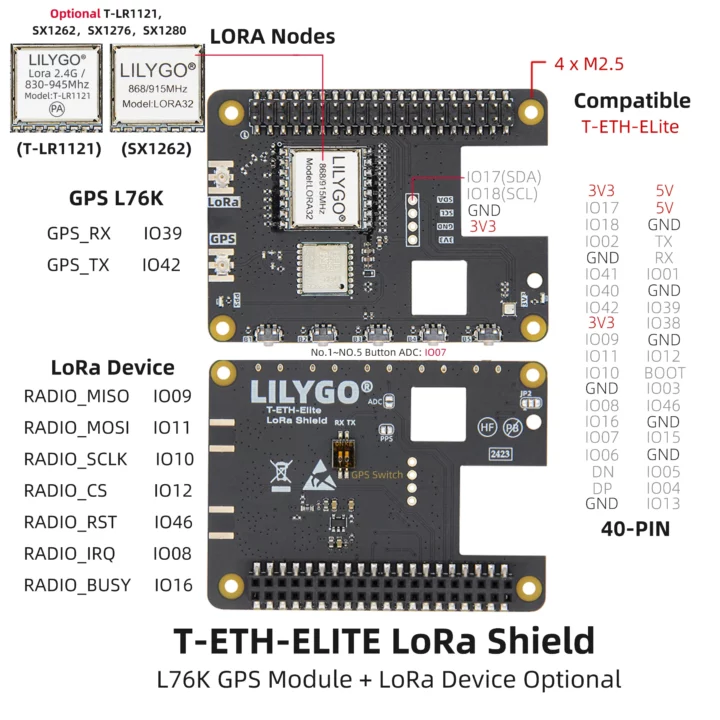
The T-ETH-Elite Gateway shield looks similar to the LTE shield, except it lacks the SIM card slot, microphone and speaker connectors, and has no DIP switch for LoRa configuration (only a 2-pin DIP switch for GPS). The LTE shield and Gateway shield can be stacked on top of each other, but the LoRa shield cannot. It can only be used directly with the T-ETH-Elite board.
It’s not the first ESP32 Ethernet board with PoE from the company, as we previously covered the T-Internet-POE and T-ETH-Lite ESP32-S3 among others, and they all share the same GitHub repository with a long list of PlatformIO/Arduino samples with client/server, WebSockets, I2C, SPI, etc… Recent commits add code samples specific to the T-ETH-Elite board and shields:
- LoRa Shield examples – LoRa_Receive_Interrupt, LoRa_Transmit_Interrupt, factory test sample
- Gateway shield test example – T-ETH-Elite-Gateway-Shield
- LTE shield test example – T-ETH-Elite-LTE-Shield
LILYGO T-ETH-Elite ESP32-S3 board can be purchased on AliExpress for $28.98 including shipping. You’ll also find the Gateway Shield ($13.98), SX1302 concentrator module with antenna ($59.98), and LTE Shield ($16.98) on that page. You’ll find the T-PCIe cellular modules on a separate page with prices going from $10.98 to $39.98.

Jean-Luc started CNX Software in 2010 as a part-time endeavor, before quitting his job as a software engineering manager, and starting to write daily news, and reviews full time later in 2011.
Support CNX Software! Donate via cryptocurrencies, become a Patron on Patreon, or purchase goods on Amazon or Aliexpress


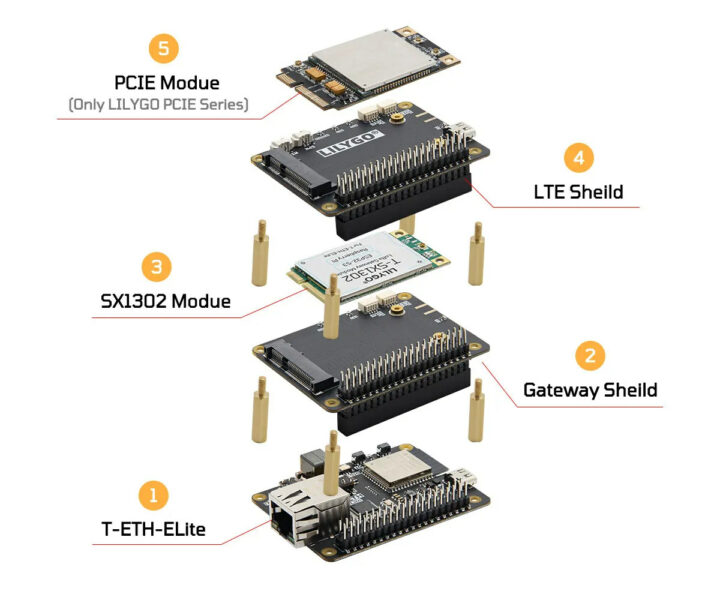
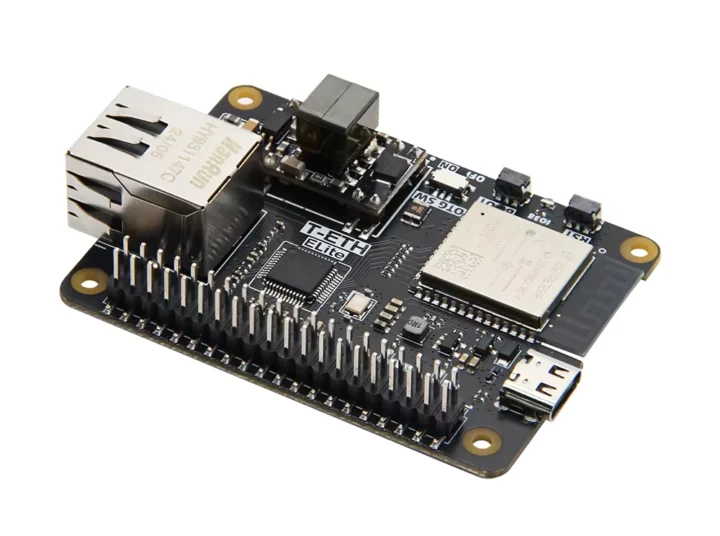
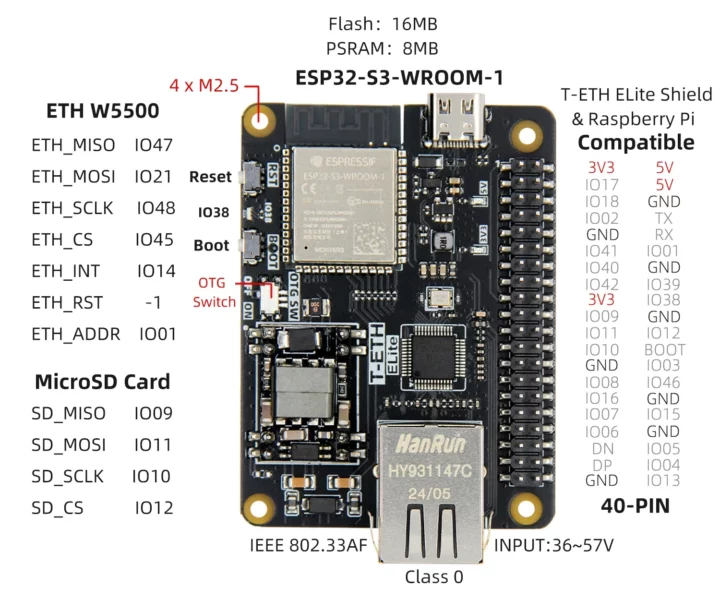



A bit of a general question. Why has the community converged on the ESP32-S3 and not the ESP32-C3. I’d have thought the lower price and RISC-V would have made it the more obvious choice. Maybe I’m missing some clear advantages for the S3 (I don’t think most people care about the AI stuff going on)
The ESP32-S3 offers more GPIO pins and PSRAM support. It could be the reason.
A few points of interest (copy and paste via the highly recommended perplexity ai app: 🙂
– Processor: S3 uses a dual-core Xtensa 32-bit LX7 processor clocked at up to 240 MHz while the C3 uses a single-core 32-bit RISC-V processor clocked at 160 MHz.
-Bluetooth: Both support Bluetooth 5.0, but the ESP32-S3 has more advanced Bluetooth capabilities.
– USB: The ESP32-S3 includes USB OTG support, which the ESP32-C3 lacks.
– Performance: The ESP32-S3 generally offers higher performance due to its dual-core architecture and higher clock speed.
– Cost: The ESP32-C3 is typically a lower-cost option, partly due to its RISC-V architecture.
So, the S3 is more capable but a little bit pr. pricier. But the C3 is RISC-V, so there’s that. 🙂